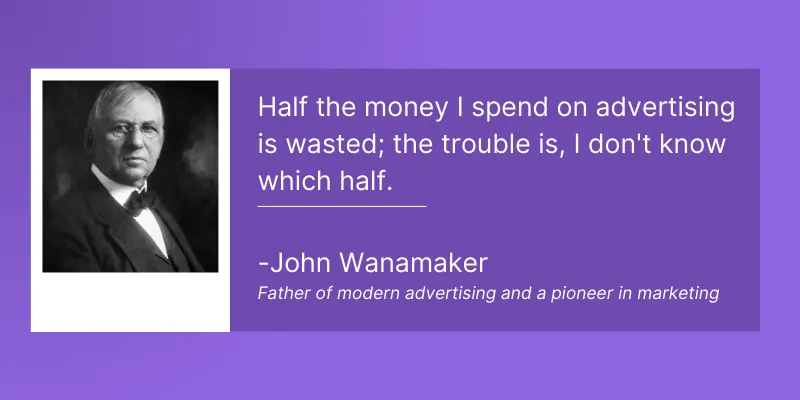From Clicks to Conversions: Understanding Performance Marketing


In today's fast-paced digital landscape, businesses constantly seek strategies that yield tangible results.
One approach that has risen to the forefront is performance marketing. Unlike traditional marketing methods, performance marketing places a strong emphasis on measurable outcomes and ROI.
In this blog, we'll delve into why performance marketing is not just a buzzword but a critical tool for businesses looking to thrive in the competitive digital marketplace.
What is Performance Marketing?
If the business owners don't have a clear picture of how and where their money is moving, if they don't understand performance marketing, then it is a sure-shot way to have failed marketing strategies!
Performance marketing is a results-driven approach to digital marketing, where advertisers pay only when specific actions or outcomes are achieved. These actions include clicks, leads, sales, or other desired customer behaviours.
Performance marketing relies on various channels, such as affiliate marketing, pay-per-click (PPC) advertising, social media advertising, and search engine marketing (SEM).
Why is it Essential to know Performance Marketing?
As John Wanamaker said, without performance marketing, businesses would not be able to understand or measure their campaigns.
Measurable ROI
Through sophisticated tracking and analytics tools, businesses can pinpoint the exact impact of their marketing efforts. This enables them to allocate resources effectively, optimizing campaigns for maximum return on investment.
Precision Targeting
Performance marketing allows for precise audience targeting. With tools like demographic profiling, behavioural analytics, and retargeting, businesses can reach the right people with the right message at the right time. This not only increases the likelihood of conversions but also minimizes wastage of resources on irrelevant audiences.
Cost-Effectiveness
Traditional advertising models often involve large upfront costs with uncertain returns. Performance marketing, on the other hand, operates on a pay-for-performance basis. Advertisers only pay when a specific action, such as a click, lead, or sale, is achieved. This ensures that marketing budgets are allocated efficiently and effectively.
Adaptability and Optimization
In the rapidly evolving digital landscape, adaptability is key. Performance marketing campaigns can be adjusted in real time based on the data and feedback received. This agility allows businesses to respond quickly to changing market conditions, ensuring their marketing efforts remain relevant and effective.
Scalability
Whether a business is a startup or a multinational corporation, performance marketing can be tailored to suit any scale. Campaigns can be scaled up or down based on budget constraints, ensuring that businesses of all sizes benefit from this approach.
Data-Driven Decision Making
Performance marketing thrives on data. Every interaction, click, and conversion is tracked and analyzed. This wealth of information empowers businesses to make informed decisions, refine their strategies, and continually improve their marketing efforts.
Usecase - With & Without Performance Marketing
Imagine a mid-sized e-commerce company, "abcTrendz," specializing in consumer electronics, gadgets, and accessories. They have a strong online presence but want to boost sales and expand their customer base.
Objective:
abcTrendz wants to increase its online sales revenue by 30% within the next quarter. They have a budget for marketing efforts and are looking for an effective strategy to achieve their goal.
Scenario 1: Without Performance Marketing
abcTrendz, a mid-sized e-commerce company, relies solely on traditional marketing methods such as print ads, billboards, and TV commercials to promote its products. They have limited visibility into the effectiveness of their campaigns and struggle to measure ROI accurately.
Results:
Limited Reach: Traditional marketing methods have a broad reach but lack precision in targeting. abcTrendz struggles to reach its specific target audience interested in consumer electronics.
Unclear ROI: It's challenging to attribute sales directly to specific campaigns. abcTrendz cannot determine which advertising efforts are driving actual revenue.
Inefficient Resource Allocation: The company allocates a significant portion of their budget to traditional advertising channels without clearly understanding their impact. This leads to the wastage of resources.
Lack of Real-time Optimization: Changes to campaigns are slow and often based on intuition rather than data. abcTrendz misses out on opportunities to adapt quickly to market trends.
Stagnant Growth: Without the ability to measure and adjust strategies in real-time, abcTrendz experiences slower growth rates than competitors leveraging performance marketing.
Scenario 2: With Performance Marketing
abcTrendz adopts a performance marketing strategy, incorporating SEM, social media advertising, email marketing, affiliate partnerships, and conversion rate optimization.
Results:
Targeted Reach: Through SEM and social media advertising, abcTrendz reaches consumers actively searching for electronics and those interested in their product offerings.
Measurable ROI: With performance marketing, abcTrendz can track every click, conversion, and sale. They know precisely how much revenue is generated from each advertising dollar spent.
Efficient Resource Allocation: The company allocates budget based on data-driven insights, ensuring resources are directed towards the most effective channels and campaigns.
Real-time Optimization: abcTrendz can make adjustments on the fly. They refine ad copy, adjust bidding strategies, and target demographics based on real-time performance data.
Exponential Growth: By leveraging the power of performance marketing, abcTrendz experiences a surge in online sales revenue. They surpassed their initial goal, achieving a 35% increase in revenue.
Facts You Should Know!
There is no one-size-fits-all marketing strategy, but here are some statistics that one should remember!
- Digital display is growing at a 15.5% CAGR, while search is projected to grow at 12.2%.
- Search accounts for 40.9% of the global digital advertising and marketing market.
- PPC returns $2 for every $1 spent—resulting in a 200% ROI.
- Paid ad channels with the highest reported ROI rate are Facebook Ads and Google Ads.
- 49% of businesses say that organic search brings the best marketing ROI.
Conclusion
Hence, performance marketing has emerged as a powerhouse in the marketing landscape. Its ability to deliver measurable results, precisely target audiences, and optimize campaigns in real time sets it apart from traditional marketing methods.
By harnessing the power of performance marketing, businesses can not only thrive but also stay ahead of the curve in the dynamic digital marketplace. Embracing this results-driven approach is not just an option; it's necessary for businesses looking to succeed in the digital age.